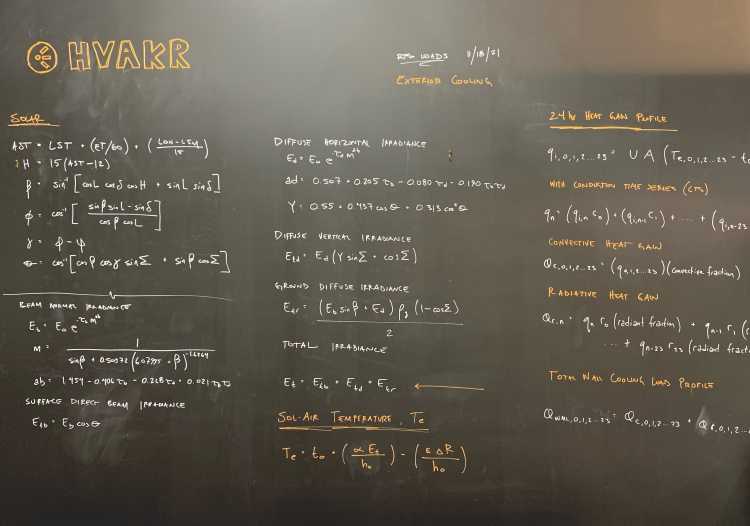
Load Calculation Methods – What Is Good?
Among other things, HVAKR is a full-fledged heating and cooling loads calculator. But what does that mean?
What are heating and cooling loads?
Simply put, a load in this context is anything that contributes to the addition or removal of heat from a building. A heating load is anything that adds demand to the building’s heating system, while a cooling load is anything that adds demand to the cooling system. For example, a single-pane window during a cold winter day is a source of heat loss for the building, making it a heating load. On the flip side, a group of salsa dancers moving to 240 beats per minute add significant heat gain to the building, making it a cooling load. Loads can be categorized into four main groups: external, internal, ventilation, and infiltration.
Our single-pane window is an example of an external load. Walls, roofs, and slabs are other sources of external loads as they contribute to heat either entering or leaving the building exterior (a.k.a building envelope).
Internal loads include people, lighting, and equipment - essentially any heat generated inside the building.
The ventilation load is the burden put on the air conditioning system from intentionally introducing outside air into the system’s air stream. During peak temperatures, this burden can be particularly high as the system must temper the air before introducing it to occupied spaces. All buildings are required to add a minimum amount of outside air to maintain freshness and replace stale air.
Infiltration is like ventilation, but unintentional. It is essentially the leakage of air in or out of the building through gaps in construction. The result is the loss of conditioned air or the introduction of outside air to the building.
Quantifying the heating and cooling loads in a building throughout the year is essential to sizing the building’s HVAC system.
How are loads calculated?
Before computers were widely available, engineers had to calculate loads by hand. Now, HVAC engineers and designers perform load calculations using programs that utilize one of several methods. The most common methods for commercial load calculations are 1) Total Equivalent Temperature Difference (TETD), 2) Cooling Load Temperature Difference (CLTD), 3) Transfer Function Method (TFM), 4) Radiant Time Series (RTS), and 5) Heat Balance (HB).
Over the years these methods have been developed by ASHRAE, and not all methods are created equal. There are many factors, but to simplify, the difference among methods comes down to how detailed each is when defining building components and calculating external loads.
The most complex aspect of load calculations is determining hourly loads for the building envelope based on weather data, solar position, and building mass properties. Early methods, like CLTD and TFM which came to popularity in the 70’s and 90’s respectively, have a limited number of inputs for building components. Though the TFM method is more mathematically intensive than CLTD, it still relies heavily on limited data tables for walls, roofs, windows, etc. The RTS and HB method, both published by ASHRAE in 2001, allow far more specificity and account for a much wider variety of component factors than their predecessors, and therefore produce more accurate results.
Between the RTS and HB method, the HB method allows for every variation of component type and is theoretically the most accurate, which is why it is used in most energy analysis software. However, there’s a balance that must be achieved when introducing a peak heating and cooling loads program: maximizing accuracy without requiring an impractical number of user-given inputs. In other words, a program may obtain highly accurate results, but if it is excessively time consuming or requires data that the user is not privy to, it isn’t as valuable as a program that can be used quickly and allows for simplification where necessary.
In this regard, the RTS method is widely recognized today as the best method for performing load calculations and is used in two of the most popular heating and cooling loads programs – Trace 700 by Trane and Block Load by Carrier. The RTS method calculates hourly loads with high accuracy and accounts for more factors than CLTD and TFM without demanding every individual component characteristic be known. It utilizes well-developed data tables for overall building construction, walls, windows, and roofs paired with a mathematically robust procedure for calculating radiant, convective, and conductive heat transfer throughout a building over time. These tables allow users to recognize and select building components rather than define envelope properties from scratch. The calculation process allows engineers and designers to confidently determine and analyze peak heating and cooling loads.
What about us?
At HVAKR, we utilize the RTS method. Since 2001, the RTS method has provided a solid mathematical platform that allows for the smooth implementation of improvements as building data becomes more developed. We will continue to observe trends in the industry and will always strive to provide the best engineering software to our users.